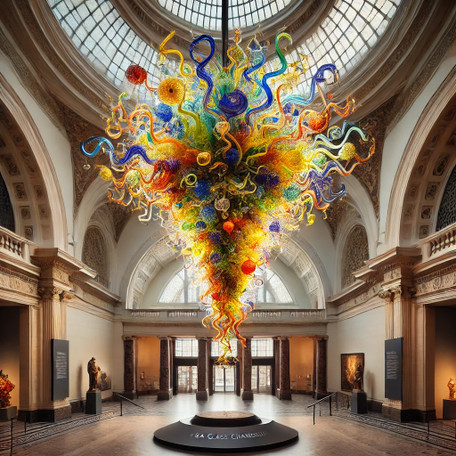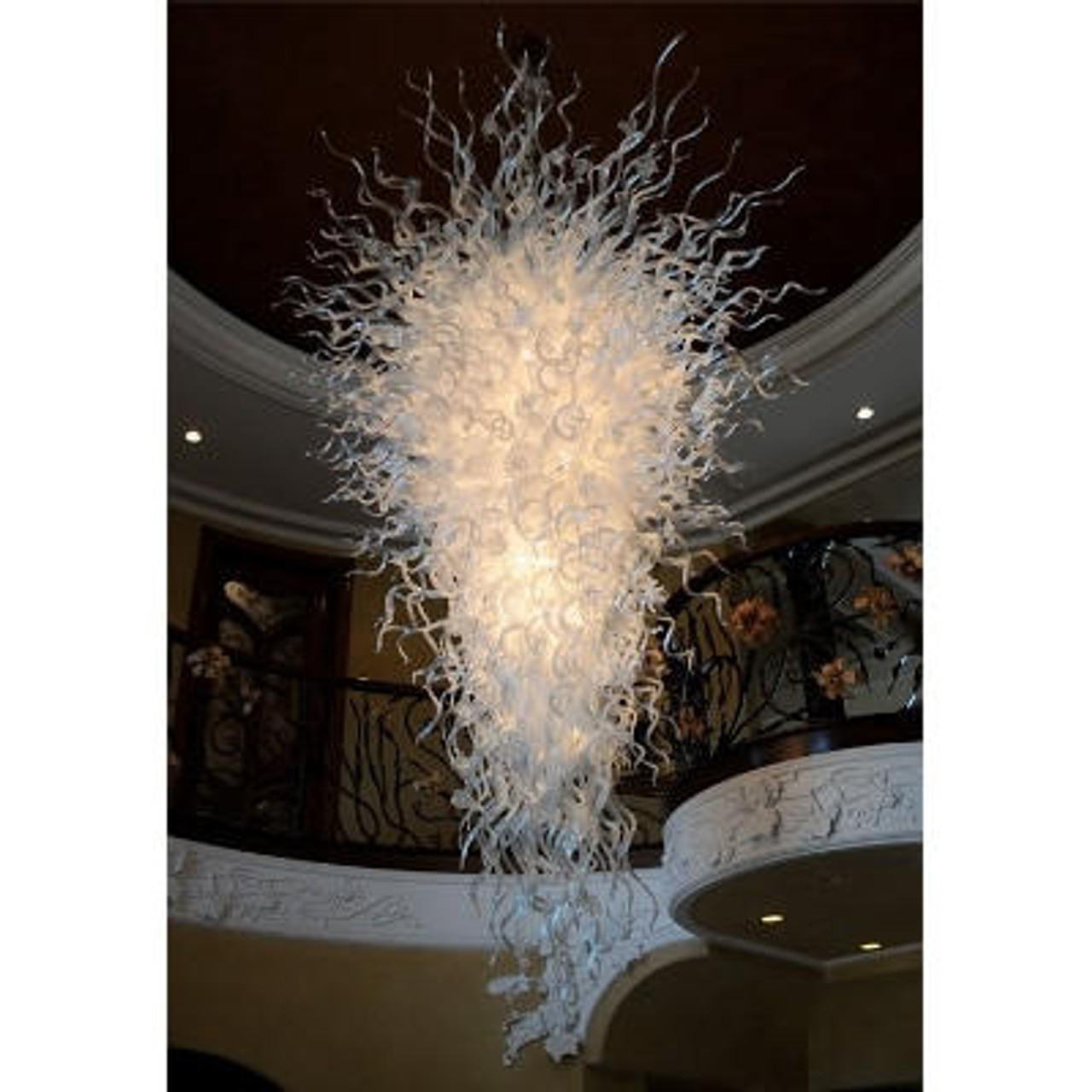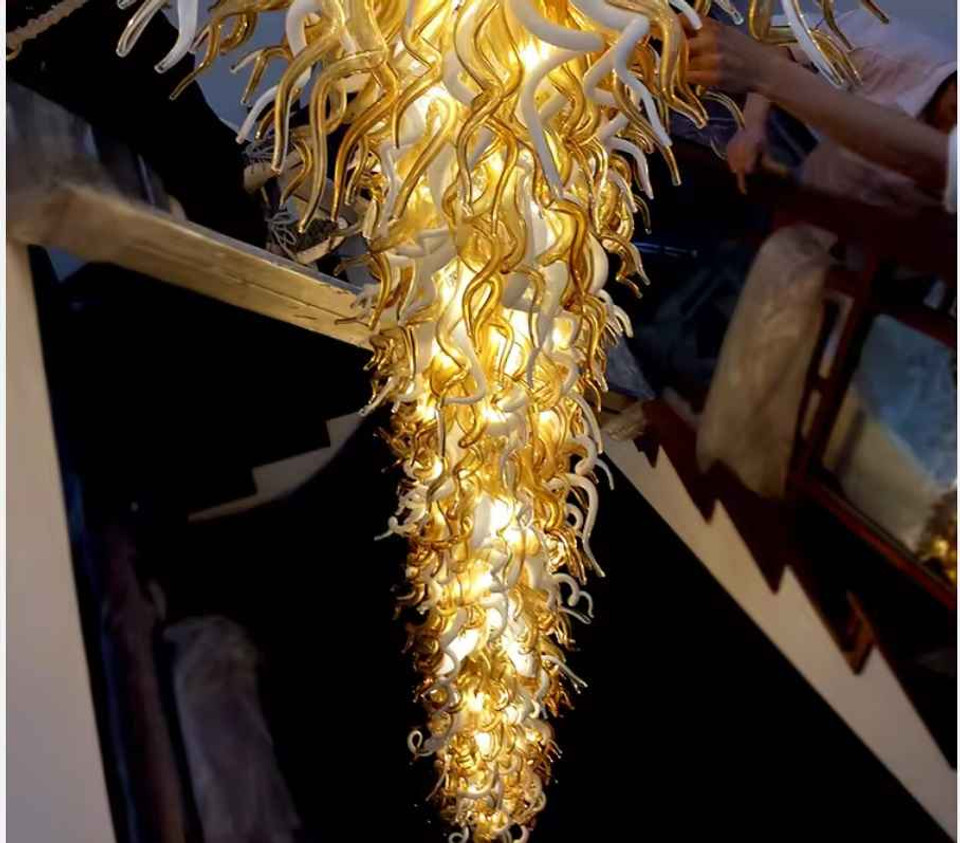V&A Glass Chandelier: A Masterpiece of Contemporary Art and Design
3rd Sep 2024
The Victoria and Albert Museum (V&A) in London is renowned for its vast collection of art and design artifacts, spanning centuries and cultures. Among the many treasures housed within its walls is a striking glass chandelier that has captivated visitors since its installation. This remarkable piece of art, known as the V&A glass chandelier, is not only a stunning visual centerpiece but also a testament to the creativity and craftsmanship of contemporary glass art.
In this blog, we'll explore the history, design, and significance of the V&A glass chandelier, delving into what makes it one of the most iconic features of the museum.
The History of the V&A Glass Chandelier
The V&A glass chandelier was created by the world-renowned American glass artist Dale Chihuly. Chihuly is celebrated for his innovative and intricate glass sculptures, which often feature vibrant colors and organic forms. His work has been exhibited in museums and galleries around the world, and his installations are known for transforming spaces with their dynamic presence.
The chandelier was commissioned by the Victoria and Albert Museum in 1999 as part of a major refurbishment of the museum's entrance. The goal was to create a piece that would not only complement the historic architecture of the museum but also make a bold statement that would capture the attention of visitors as they entered the building.
Chihuly rose to the challenge, designing a chandelier that is both grand in scale and intricate in detail. The piece, officially titled "Rotunda Chandelier," was unveiled in the museum's grand entrance hall in 2001, where it has since become an iconic symbol of the V&A.
Design and Aesthetics
The V&A glass chandelier is a masterpiece of contemporary glass art, showcasing Chihuly's signature style. The chandelier is composed of thousands of hand-blown glass pieces, each one unique in shape and color. These individual elements are assembled into a towering structure that hangs from the ceiling of the museum's rotunda, creating a dazzling display of light and color.
One of the most striking features of the chandelier is its use of color. Chihuly is known for his bold and vibrant color palettes, and the V&A chandelier is no exception. The glass pieces range from deep blues and greens to bright yellows and oranges, creating a dynamic interplay of colors that changes as the light shifts throughout the day.
The design of the chandelier is organic and fluid, with the glass elements resembling natural forms such as flowers, tendrils, and sea creatures. This organic quality gives the chandelier a sense of movement and life, as if it were a living entity suspended in mid-air.
The scale of the chandelier is also impressive. Standing over 30 feet tall, it dominates the entrance hall of the museum, drawing the eye upward and creating a sense of awe. Despite its size, the chandelier has a lightness and delicacy that belies its complexity, making it a true marvel of glass artistry.
Significance and Impact
The V&A glass chandelier is more than just a decorative piece; it is a work of art that embodies the museum's commitment to celebrating design and creativity. Since its installation, the chandelier has become one of the most photographed and admired features of the V&A, attracting visitors from around the world.
The chandelier also represents a significant moment in the history of contemporary glass art. Chihuly's work has played a key role in elevating glass from a craft medium to a recognized form of fine art, and the V&A glass chandelier is a prime example of this shift. By placing such a bold and contemporary piece at the heart of one of the world's most prestigious art and design museums, the V&A not only acknowledges the artistic value of glass but also challenges traditional notions of what can be considered fine art.
Chihuly's Legacy and the Role of the Chandelier in the V&A
Dale Chihuly's influence on the world of glass art is profound. His ability to push the boundaries of the medium, creating large-scale installations that are both technically complex and visually stunning, has earned him international acclaim. The V&A chandelier is a testament to Chihuly's mastery of glass and his ability to create works that resonate with a broad audience.
The chandelier serves as a gateway to the museum, setting the tone for the experience that awaits visitors. It embodies the V&A's mission to inspire creativity and innovation, bridging the gap between historical collections and contemporary art. The chandelier's presence in the museum emphasizes the importance of contemporary works in a historical context, showing how modern art can dialogue with and complement the past.
The Process of Creating the V&A Glass Chandelier
Creating the V&A glass chandelier was no small feat. The process began in Chihuly's Seattle studio, where he and his team of skilled glassblowers meticulously crafted each individual piece of the chandelier. The glass elements were hand-blown using techniques that have been refined over centuries, but with Chihuly's own innovative approach to form and color.
Once the pieces were completed, they were shipped to London, where the chandelier was assembled on-site. The installation process was complex, requiring careful planning and coordination to ensure that each piece was securely attached and that the overall structure was stable. The result is a chandelier that is both a technical marvel and a work of art, with every detail carefully considered.
Visitor Experience and Interaction
The V&A glass chandelier is more than just a visual spectacle; it also plays a significant role in shaping the visitor experience. As guests enter the museum, the chandelier immediately draws their attention, creating a sense of wonder and excitement. Its vibrant colors and intricate details invite closer inspection, encouraging visitors to explore the museum with a sense of curiosity and appreciation for the artistry on display.
The chandelier also provides a unique backdrop for events and exhibitions held at the museum. Whether it's a gala, a special exhibition opening, or an educational program, the chandelier enhances the ambiance, adding a touch of elegance and sophistication to any occasion.
The Chandelier in Popular Culture
Over the years, the V&A glass chandelier has become an icon in its own right, appearing in numerous publications, documentaries, and social media posts. It has been featured in travel guides, art books, and magazines, further cementing its status as a must-see attraction for visitors to London.
The chandelier's popularity extends beyond the art world; it has become a cultural symbol, representing the fusion of traditional craftsmanship and modern design. Its presence at the V&A serves as a reminder of the power of art to inspire and transform, making it a fitting centerpiece for a museum dedicated to the celebration of human creativity.
Conclusion: The Enduring Appeal of the V&A Glass Chandelier
The V&A glass chandelier is more than just a piece of decoration; it is a masterpiece that captures the imagination of all who see it. Through its vibrant colors, intricate design, and monumental scale, it exemplifies the beauty and potential of contemporary glass art. Dale Chihuly's creation has become an integral part of the Victoria and Albert Museum, symbolizing the institution's commitment to innovation, creativity, and the celebration of art in all its forms.
For anyone visiting the V&A, the chandelier is a must-see, offering a breathtaking introduction to the wonders that lie within the museum's galleries. Its enduring appeal is a testament to the power of art to inspire and captivate, making it one of the most beloved features of the museum and a true icon of contemporary design.





